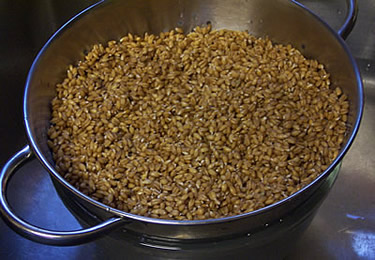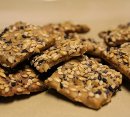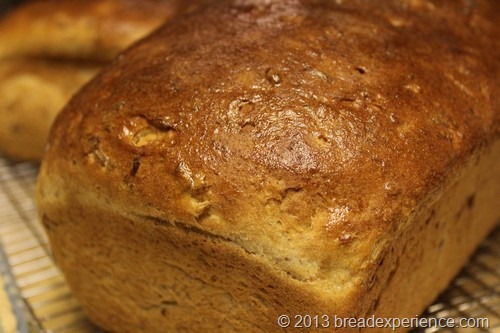Making sprouted bread is like working on a fun science project. You take the grain, water it, and it sprouts to life. I wasn’t into science very much while I was growing up, but I always enjoyed projects that involved seeds and growing. It’s so satisfying to nurture a plant and watch it come to life. Although wheat is a grass, when it is sprouted, the body processes it more like a vegetable than a grain.
Using sprouted wheat in breads adds unique texture and crunch to the loaves, and it greatly enhances the nutrition and digestibility of the grains. So not only do these types of breads taste great, but they are better for you, and are generally easier to digest than breads made with just flour. If you haven’t tried making bread with sprouted grains before, you’re in for a treat.
Loaves made with sprouted wheat make great sandwich breads. They are the perfect take-along food for a hike in the mountains or for a simple lunch with peanut butter and jelly. There’s just something earthy and comforting about these types of breads.
The sprouting process takes a few days so the anticipation heightens while you’re waiting for the tiny little sprout to grow and peep out of the tip of the grain. Another cool thing about this seed (or grain rather) is that it doesn’t require any sunlight to nuture it. It’s best to keep the grains in a cool, dark place during the sprouting process.
Methods for Making Sprouted Bread
If at first you don’t succeed, try and try again. Sometimes it is tricky to get the timing down when you’re sprouting wheat berries for sprouted bread. You might have the time to bake, but the sprouts aren’t ready or the sprouts might be ready when you’re not. If the berries sprout too much before you can use them for bread, just enjoy them in a salad or as a side dish and try again. It’s worth it!
There are several different methods for making sprouted bread. Try one of the methods below. If you have a different method, please feel free to share it. We appreciate the feedback!
- One way to use sprouted wheat in breads is to germinate (or sprout) the wheat berries, dry the sprouts and then grind them into flour. This boosts the vitamin content of the flour. Partially germinated seeds contain considerably more vitamins B and C and dramatically increase carotene levels (commonly known as vitamin A). Many people who are allergic to refined wheat products have been helped by eating germinated grains.
- Another method for making sprouted bread is to sprout the wheat berries, chop them up and add them to breads for extra nutrition and added texture. See recipe #1 below.
- You can also make sprouted wheat bread with just sprouted wheat and no flour. Germinate the wheat berries using the method outlined in the next section and then use your food processor (or strong arms) to knead the sprouts into dough. See recipe #2 below.
How to Germinate Wheat Berries
Use wide-mouth quart jars and fill them 1/3 full with the grains (wheat berries).
Fill the jar with water and let it rest in a dark place at room temperature for 8-12 hours, or until at least half of the berries are just barely sprouted; drain, rinse with fresh water, and drain again.

How long should you sprout the berries?
- Sprout the berries just until the tiny sprout is barely beginning to show and the grain itself is tender – this could take anywhere from 18 hours to 36 hours, depending on the temperature in your house.
- If the grain sprouts develop long enough for diastatic enzymes to get started, the bread will become very gooey and won’t bake through. You will end up with a brick.
What if I’m not ready to use the sprouts just yet?
- If you sprout the grains, but aren’t quite ready to use them, place them in the refrigerator for a day or so. Just remember they will continue germinating in the refrigerator so don’t wait too long. When you remove the grains from the refrigerator, let them drain on a paper towel to remove any access moisture.
Use the sprouts in bread at this point or dry them to make flour.
Drying the sprouts for flour:
- To dry the sprouts for flour, place a thin layer on baking sheets. Place in oven on low heat overnight or until completely dry. Grind into flour.
- Note: If the berries aren’t completely dry, they will clog your grinder.
Sprouted Bread Recipes
Here are some recipes for making breads with sprouted wheat and other grains.
 |
Sprouted Bread with sprouted wheat & bread flour The wheat berries provide a crunchy and sweet flavor to this delicious golden loaf. |
 |
Sprouted Wheat Bread with sprouts and no flourThis method for making sprouted wheat bread with no flour produces a light loaf that doesn’t look or taste like a brick. |
 |
Cinnamon Raisin Bread with Oatmeal & Sprouted Wheat FlourOatmeal with cinnamon and raisins is delicious and healthy; when you add the combination to bread, you’ve got yourself a pretty awesome treat. |
 |
Crunchy Sprouted Wheat CrackersThese crunchy crackers are filled with seeds on the inside and studded with additional seeds on the outside. |
 |
Russian Mountain Braid with Sprouted Wheat FlourThis bread is a beautiful braided bread that is baked in a spring form pan to help hold it’s shape. |
 |
Sprouted Barley BreadThe texture and flavor of this Sprouted Barley Bread is wonderful. |
 |
Sprouted Einkorn BreadThis is a very light bread, rich in flavor and nutty due to the sprouted einkorn berries and flour. |
 |
Sprouted Einkorn Bread with no FlourAs the name suggests, this Sprouted Einkorn Bread is made completely with sprouted Einkorn grains and no flour. |
 |
Sprouted Emmer BreadEmmer has a bold-flavor and usually makes a heavy and dense bread compared to wheat bread. I used a combination of sprouted Emmer grains, Emmer flour and bread flour to make a lighter bread. |
 |
Sprouted KAMUT BreadThis loaf is a little bit chewy (in a good way) and tastes great toasted with butter and/or spread with jam. |
 |
Sprouted KAMUT Bread with no flourThis bread is made completely with sprouted KAMUT grains and no flour. |
 |
Sprouted Rye and Spelt BreadThis Sprouted Rye and Spelt Bread is made with sprouted rye berries, rye flour and all-purpose Spelt flour. |
 |
Sprouted Spelt BreadSprouted Spelt Bread is made with sprouted spelt grains and spelt flour. It takes a couple of days to sprout the grains but it’s worth the extra effort. |
 |
Swedish Rye Bread with Sprouted Wheat FlourThis delicious bread includes honey, grated orange peel, anise seeds, and caraway seeds as well as some white bread flour, rye flour and sprouted wheat flour. |
 |
Whole Wheat Bread made with sprouted wheat flourThis 100% Whole Wheat Bread can be made with no added fat or sweetener. |
Learn more about whole grains & flours:
Types of Wheat – There are six main types of wheat grown in the United States. Within these different types of wheat, there are many varieties and substrains that offer an array of possibilities for millers as well as bakers.
Types of Flour – Flour is the primary ingredient in bread. The kind of flour used will determine the nature of the loaf. The better the flour, the better your bread will taste. In this section, we list the main types of flour that can be used to make bread.
Wheat Flours – Wheat flours are the main ingredient in most bread products. Wheat is rich in gluten, a protein that gives dough its elasticity and strength. Learn more about wheat flours in this section.
Wheat Grains – By-products of milling white flours are unprocessed wheat bran and wheat germ. They add color, nutrition, and fiber to breads. Learn about other types of wheat grains that can be used in breads.
Non-Wheat Flours – There are a number of non-wheat flours that can be used as substitutes for wheat flour in breads. Wheat-free (gluten-free) flour can also be used in breads made with wheat flour to enhance the flavor and provide unique texture.
Organic Bread Flour – If you don’t want to get into home milling your own flour, try organic bread flour. It costs a little more than non-organic flour, but it is worth it! The bread baked with organic flour is better for you than most non-organic flour.
Try some of these whole grains for home milling your own flour.


Lyliana says
Thank you very much for your recipe!!! I am having problems sprouting the wheat. I live in Bogota-Colombia South America, the temperature is 15°C- 59°F. I really dont know if Iam doing a mistake. The taste of the bread is deliciuos, but is like a brick. How long should be the sprout in milimeters?? Just seing a white point in the grain???
The altitude is 9000 feet, should I increase the yeast?? I made the #2 recipe.
What other products can I make with sprouded Wheat??
Thank you very much….!!!
Best Regards.
Cathy says
Hello Lyliana, thank you for visiting the Bread Experience. I had always heard that you should sprout the berries just until the nub breaks through. When it is just beginning to sprout. However, more recently, I’ve heard that in order for the wheat berries to be more digestible, you should wait until the nub splits into two separate shoots because that is the point when the wheat berries become vegetables. It also works best if you process your sprouts using a food processor or meat grinder. You can do it in a high-powered blender, but it won’t process the berries as finely which will also make a difference in how light the dough is. This can be a tricky bread to make, but it’s worth the effort.
You can also dry the sprouts and grind them into flour for use in bread recipes instead of using regular flour. And, you can eat the sprouted berries as a hot cereal.
t says
I’m wanting to make home made ezekiel bread from sprouted grains. where can I buy the grains and legumes? I need dried wheat berries, barley, spelt, millet, and green lentils. Would a grocery store have these?
Cathy says
Hello, a grocery store wouldn’t have the wheat, barley or spelt berries, but they might carry the green lentils. You might try a farmer’s market or you can order online.
Happy Baking!
Cathy
Bud says
Hi Cathy,
I want to use recipe #3 – sprouts only – but barley instead of wheat [mainly, because I have quite a bit of barley]. I went to the barley recipe but it doesn’t talk about doing sprouts only. I imagine it would not matter – that I could use recipe #3 with barley. But, my imagination has gotten me in trouble before. 🙂
Do you know would that work?
Cathy says
Hi Bud, I haven’t made sprouted bread using only barley sprouts. I know that using a portion of barley sprouts works well, but you need the regular wheat to provide structure.
I’m thinking it might turn out like a brick with only barley sprouts, but like I said, I haven’t tried it. If you decide to try it with only barley sprouts, let me know how it goes.
Andreia says
I tried to sprout kamut and barley and nothing happened. After a few days I had to throw everything away because it started smelling. What could have been wrong? So we need to buy special grains?
Cathy says
I use organic grains and have never had a problem getting them to sprout. You do need to rinse them in cool, fresh water first and drain them. Apparently, some seeds are covered in resin so they might require several rinses before you start the sprouting process.
An alternate method of sprouting is to rinse the grains (several times, if necessary), then place the grains in a bowl or canning jar, cover them with water and let them sit in the water for 3 to 5 hours. Then rinse and drain the grains again. Let the drained grains sit for several more hours until evening, then rinse them again and let them drain overnight – in a strainer, or a jar fitted with a screened lid or cheesecloth. The next day – approx. 8 -12 hours, depending on how hot it is in your kitchen, you should see the nub start to break through.